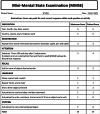Adult Onset Vanishing White Matter Disease: A Rare Case Report
- PMID: 36397907
- PMCID: PMC9648176
- DOI: 10.7759/cureus.30177
Adult Onset Vanishing White Matter Disease: A Rare Case Report
Abstract
Vanishing white matter disease (VWMD) is the most common childhood-onset inheritable progressive leukodystrophy disorder, which exclusively affects the white matter of the brain. It shows mutations in one of the five eukaryotic translation initiation factor 2B1-5 genes following an autosomal recessive pattern, of which eIF2B5 mutation is the most frequent. These genes play a vital role in the translation and regulation of protein synthesis and mutation in them leads to a dysregulation of the cellular stress response, which in particular disrupts myelination and affects oligodendrocytes and astrocytes while sparing the neurons. Stressful situations, for example, head trauma, sudden fright, acute psychological stress, or infection, provoke severe and rapid neurological deterioration. Although it is more common in childhood, we report a case of an adult presenting with signs and symptoms of VWMD, such as abusive behavior, emotional liability, and motor incoordination. To our knowledge, this is the first case of adult-onset VWMD in Maharashtra, India, confirmed by magnetic resonance imaging (MRI) of the brain.
Keywords: cerebral leukodystrophy; india; progressive ataxia; psychiatric; vanishing white matter.
Copyright © 2022, Nagdev et al.
Conflict of interest statement
The authors have declared that no competing interests exist.
Figures



Similar articles
-
Adult-onset vanishing white matter disease with the EIF2B2 gene mutation presenting as menometrorrhagia.BMC Neurol. 2019 Aug 22;19(1):203. doi: 10.1186/s12883-019-1429-9. BMC Neurol. 2019. PMID: 31438897 Free PMC article.
-
An eleven-year history of Vanishing White Matter Disease in an adult patient with no cognitive decline and EIF2B5 mutations. A case report.Neurocase. 2021 Dec;27(6):452-456. doi: 10.1080/13554794.2021.1999984. Epub 2021 Nov 9. Neurocase. 2021. PMID: 34751098
-
Vanishing white matter disease presenting as opsoclonus myoclonus syndrome in childhood--a case report and review of the literature.Pediatr Neurol. 2014 Jul;51(1):157-64. doi: 10.1016/j.pediatrneurol.2014.03.008. Epub 2014 Mar 15. Pediatr Neurol. 2014. PMID: 24938145 Review.
-
Leukodystrophy Due to eIF2B Mutations in Adults.Can J Neurol Sci. 2022 Sep;49(5):708-712. doi: 10.1017/cjn.2021.202. Epub 2021 Sep 2. Can J Neurol Sci. 2022. PMID: 34663487
-
Childhood ataxia with CNS hypomyelination/vanishing white matter disease--a common leukodystrophy caused by abnormal control of protein synthesis.Mol Genet Metab. 2006 May;88(1):7-15. doi: 10.1016/j.ymgme.2005.10.019. Epub 2006 Jan 18. Mol Genet Metab. 2006. PMID: 16378743 Review.
Cited by
-
A rare case of adult-onset vanishing white matter leukoencephalopathy with movement disorder, expressing homozygous EIF2B3 and PRKN pathogenic variants.BMC Neurol. 2025 Jan 4;25(1):7. doi: 10.1186/s12883-024-04018-y. BMC Neurol. 2025. PMID: 39755597 Free PMC article.
References
-
- The first report of relative incidence of inherited white matter disorders in an Asian country based on an Iranian Bioregistry System. Ashrafi MR, Rezaei Z, Heidari M, et al. J Child Neurol. 2018;33:255–259. - PubMed
-
- Vanishing white matter disease: Phenotypic, MR imaging and 1H spectroscopic observations. Ravishankar S, Sinha S, Taly A, et al. Ann Indian Acad Neurol. 2006;9:172.
Publication types
LinkOut - more resources
Full Text Sources
